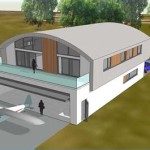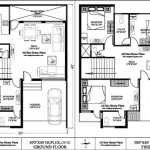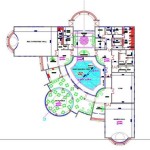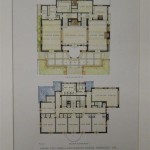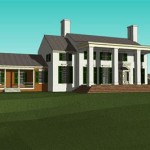Hurricane-Proof House Floor Plans: Designing for Resilience
The increasing frequency and intensity of hurricanes necessitate a reevaluation of residential construction practices, particularly in vulnerable coastal regions. Hurricane-proof house floor plans represent a comprehensive approach to building design, integrating structural integrity with functional living spaces to minimize damage and maximize occupant safety during severe weather events. This article explores the critical aspects of hurricane-resistant design, focusing on floor plan considerations, material selection, and construction techniques that contribute to a resilient and durable home.
Designing a hurricane-proof home is not simply about reinforcing existing structures. It requires a holistic approach that considers the entire building envelope, from foundation to roof, and how each element interacts with potential hurricane forces. The floor plan plays a crucial role in this process, influencing the overall structural stability and the distribution of loads during high winds and flooding. Careful planning and adherence to stringent building codes are essential to creating a safe and secure living environment in hurricane-prone areas.
Key Point 1: Structural Integrity and Floor Plan Geometry
The shape and layout of a house significantly influence its ability to withstand hurricane-force winds. Simple, symmetrical floor plans tend to perform better than complex, irregular designs. Rectangular or square shapes, with minimal protrusions and indentations, offer greater structural stability and reduce the likelihood of wind pressure concentration. These shapes minimize sharp corners and angled surfaces, which can act as stress concentrators and points of vulnerability during high winds.
Open floor plans, while popular for their aesthetic appeal and spacious feel, can sometimes compromise structural integrity if not properly engineered. Large, unsupported spans require robust structural elements to resist lateral loads from wind pressure. Reinforced beams, columns, and shear walls are essential to maintain the structural integrity of open living spaces. Careful consideration should be given to the placement and spacing of these structural components to ensure adequate support and load distribution.
Internal walls also contribute to the overall structural stability of a house. Strategically positioned interior walls can act as shear walls, providing additional resistance to lateral forces. The floor plan should incorporate these walls in a manner that effectively braces the exterior walls and roof, minimizing deformation and preventing collapse. The connections between walls, floors, and roofs are particularly critical, as these are often the weakest points in a structure. Properly designed and constructed connections can significantly enhance the house's ability to withstand hurricane-force winds.
The foundation is the bedrock of any hurricane-resistant home. Elevated foundations are highly recommended in flood-prone areas, as they protect the living spaces from rising water levels. Pilings, piers, or a continuous concrete foundation can provide a stable and resilient base for the house. The floor plan should integrate seamlessly with the foundation design, ensuring that the loads from the structure are effectively transferred to the ground. The foundation must be designed to resist both uplift forces from wind and hydrostatic pressure from floodwaters.
In addition to the overall shape and internal layout, the orientation of the house on the lot should also be considered. Orienting the house with its long axis perpendicular to the prevailing wind direction can reduce the wind pressure on the building envelope. This orientation minimizes the surface area exposed to the strongest winds, thereby reducing the overall load on the structure. Landscape design can also play a role in mitigating wind forces, with strategically placed trees and shrubs providing a windbreak and reducing the impact of gusts.
Key Point 2: Material Selection and Building Techniques
The choice of building materials is paramount in constructing a hurricane-proof home. Materials should be selected for their strength, durability, and resistance to wind, water, and impact. Concrete, reinforced masonry, and steel are commonly used for structural elements, providing superior resistance to high winds and impact from flying debris. Wood framing, while still a viable option, requires careful design and construction to ensure adequate resistance to hurricane forces. Utilizing pressure-treated lumber can enhance its resistance to moisture and decay, further improving the longevity of the structure.
Roofing materials are particularly vulnerable to damage during hurricanes. Metal roofing, such as aluminum or steel, offers excellent wind resistance and can withstand high winds without being torn off. Concrete or clay tiles, when properly installed, can also provide a durable and attractive roofing option. Asphalt shingles, a more common roofing material, should be installed with additional fasteners and sealants to prevent wind uplift. Regardless of the roofing material chosen, it is essential to ensure that it is properly attached to the roof deck with appropriate fasteners and techniques.
Windows and doors are often the weakest points in a building envelope during a hurricane. Impact-resistant windows and doors, designed to withstand the impact of flying debris, are a critical component of a hurricane-proof home. These windows and doors are typically constructed with laminated glass or polycarbonate glazing, which can absorb the impact of projectiles without shattering. In addition to impact resistance, windows and doors should also be properly sealed to prevent water intrusion during heavy rains and storm surge. The frame materials should also be durable and resistant to corrosion, ensuring long-term performance in a coastal environment.
Wall cladding materials should also be selected for their resistance to wind, water, and impact. Stucco, brick veneer, and fiber-cement siding are all durable options that can provide adequate protection for the exterior walls. These materials should be properly installed with appropriate fasteners and sealants to prevent wind uplift and water intrusion. The wall cladding should also be designed to allow for proper drainage and ventilation, preventing moisture buildup and decay within the wall cavity.
Advanced construction techniques, such as using hurricane straps and clips, can significantly enhance the structural integrity of a house. These metal connectors are used to tie the roof to the walls and the walls to the foundation, preventing uplift and lateral movement during high winds. Properly installed hurricane straps and clips can significantly increase the house's ability to resist hurricane forces and prevent catastrophic failure.
Key Point 3: Flood Resistance and Mitigation Strategies
In addition to wind resistance, flood resistance is a critical consideration in hurricane-prone areas. Elevated foundations, as previously mentioned, are a primary strategy for protecting living spaces from rising water levels. However, other flood mitigation measures may also be necessary, depending on the specific location and flood risk.
Flood vents are openings in the foundation walls that allow floodwaters to enter and exit the building, equalizing the hydrostatic pressure on the walls and preventing collapse. These vents should be properly sized and located to effectively relieve pressure during a flood event. The floor plan should incorporate the placement of flood vents into the foundation design, ensuring that they are accessible and functional.
Water-resistant materials should be used in areas that are susceptible to flooding, such as basements and ground-level entryways. Concrete, tile, and closed-cell foam insulation are all water-resistant materials that can minimize damage from floodwaters. Electrical systems and appliances should be elevated above the base flood elevation to prevent damage and reduce the risk of electrocution. The floor plan should take these considerations into account, specifying appropriate materials and construction techniques for flood-prone areas.
Landscaping can also play a role in flood mitigation. Grading the land away from the house can help to divert water away from the foundation. Planting trees and shrubs can help to absorb rainwater and reduce runoff. However, it is important to avoid planting trees too close to the house, as their roots can damage the foundation and their branches can fall on the roof during a storm.
Developing a comprehensive evacuation plan is also essential for hurricane preparedness. The floor plan should facilitate easy and safe evacuation from the house. Multiple exit routes should be available, and emergency supplies should be stored in a readily accessible location. Families should practice their evacuation plan regularly to ensure that they are prepared to respond quickly and effectively in the event of a hurricane.
Finally, homeowner's insurance is an important safety net for mitigating financial losses from hurricane damage. Flood insurance is particularly important in flood-prone areas, as standard homeowner's insurance policies typically do not cover flood damage. Homeowners should carefully review their insurance policies to ensure that they have adequate coverage for wind, flood, and other potential hurricane-related losses.

Hurricane Proof Homes Stilt Houses Piling Topsider

Hurricane Proof House Plans Goodbye Bunker O Gorgeous

Hurricane Proof Homes Stilt Houses Piling Topsider

Hurricane Proof Homes Stilt Houses Piling Topsider

Floorplan Gallery Round Floorplans Custom Floor Plans House

Hurricane Proof Homes Stilt Houses Piling Topsider

Hurricane Proof Homes Stilt Houses Piling Topsider

Hurricane Proof Homes Stilt Houses Piling Topsider


Hurricane Proof Homes Stilt Houses Piling Topsider


